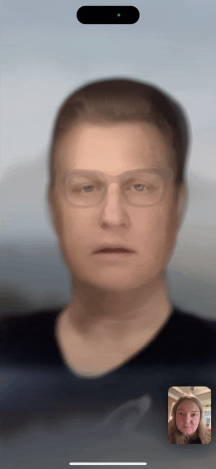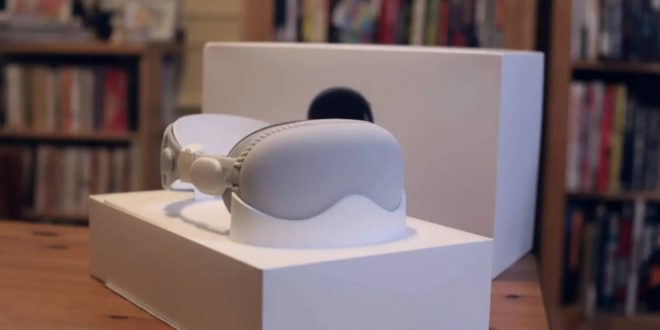Today is Friday, February 2, 2024. Today is the day. You’ve had your sights set on the Vision Pro ever since Tim Cook unveiled it at last year’s WWDC. Even when considering the years of rumors, leaks, and renderings, it’s safe to say that the wait has been quite extensive. The price fell short of your expectations, but considering it’s a first-generation product, it’s understandable. Manufacturing is not yet operating at its full potential for consumers, and it is important to consider the significant investment of time and resources that went into seven or eight years of research and development.
After some deliberation, you finally made the decision to click the “Buy” button. With anticipation, you took a deep breath, shut your eyes, and made the purchase for a hefty $3,500. Well done, you’re one of the first to try it out.
A package is delivered. This thing is massive. The product embodies the essence of Apple – it exudes a sense of luxury and has been meticulously crafted with a clear purpose in mind. To remove the top, simply tear the tabs on the other side and slide it off. The visor is enclosed within, securely fastened to a compact platform that resembles a showcase rather than a mere shipping container. Upon closer inspection, additional discoveries await: an extra strap and a second insert for the “light seal”.
Personally, I am currently quite fond of the Dual Loop Band. The Solo Knit Band may have a more visually appealing design, but the Vision Pro outshines it in terms of weight distribution. This headset is not lightweight, but the top strap effectively manages the weight. For those who wear glasses, it’s recommended to opt for the larger light seal inserts. This will help create more distance between your eyes and the inserts.
And finally, we come to the notorious battery pack. Insert it into the port on the left side and give it a twist. A small white light flickers before becoming steady. The game has started.
After eight months, what’s another 60 seconds between friends? There’s a bit of a setup process. Understandably so. The Vision Pro has to orient its sensors and get to know your space and lighting. If you had Zeiss optical inserts made for your vision, now is the time to snap them in magnetically. If you’re a glasses wearer, don’t freak out about the image too much until you’ve enrolled your lenses by holding up a piece of paper with a QR-like code on it. Pairing the device with your iPhone works in much the same fashion.
You’ll be asked to pull the headset off for a bit, to take a scan of your face. But first, a short introductory video.
The face scan process utilizes the camera on the front of the visor to construct a shoulders-up 3D avatar. The process is extremely similar to enrolling in Face ID on your iPhone. Look forward. Turn your head to the side. Then the other. Look up and rotate down. Look down and rotate up. Find some good lighting. Maybe a ring light, if you have one. If you wear glasses, make a point not to squint. I apparently did, and now my persona looks like it spent the last week celebrating the passage of Ohio’s Issue 2 ballot measure.

The publicly released Personas have received a varied reception. The influencers all did a fantastic job. Could the lighting be the culprit? Are genetics the key? Perhaps it’s Maybelline. Best of luck with your endeavor, and remember, there’s always room for improvement if you didn’t quite nail it on the first try. Is it mine? This is the superior option out of the two I’ve tried out thus far. I appear as a character with a unique appearance, resembling a thumb with a distinct huffing habit. This situation accentuates the persistent Bell’s palsy in my right eye. Or perhaps more of a quirky Max Headroom? I’ll give it another shot tomorrow, but in the meantime, it’s important to keep in mind that the feature is essentially still in beta.
This is the persona you’ll be embodying when engaging with others via FaceTime and other teleconferencing apps. It’s interesting how this solution addresses the challenge of having a visor on your face and the potential absence of an external camera. It certainly requires a bit of adjustment.
If you wish to modify your hair or shirt, you will need to retake it. I was expecting a higher level of adaptability, similar to Memojis, but unfortunately, it is not included in the current feature set. The device is capable of detecting and responding to various facial expressions, such as smiling, raising eyebrows, and even sticking out your tongue. This feature can come in handy during Zoom work calls. The scan is utilized to create an image of your eyes for the EyeSight feature on the front of the visor, which notifies others in the room when you are gazing in their direction.
Reposition the headset and raise your hands to ensure the hand-tracking feature is properly calibrated. Following that, a trio of circles filled with dots will emerge, with each one radiating a more intense glow than the previous. Here you’ll need to carefully examine each one by pinching your thumb and index fingers together. This feature is beneficial for fine-tuning eye tracking accuracy.
Input has always been a topic of debate in the realm of extended reality. In the realm of gaming, the headset allows for the seamless integration of Bluetooth game controllers, keyboards, and trackpads. However, Apple envisions a future where the primary means of interaction relies heavily on your eyes and hands. Take a moment to focus on an object and use a gentle pinch of your fingers to make your selection. Pinches are utilized for zooming (by pinching with both hands and pulling them apart) and scrolling (by pinching and swiping).
The digital crown is an essential tool that enhances your user experience. It’s essentially an enlarged iteration of the one found on your Apple Watch. When you press it, an apps display pops up, resembling Launchpad on MacOS. The app’s sidebar also features a variety of Environments and People/Contacts for users to explore. When you long-press the crown, visionOS conveniently centers where you’re looking.
For those who have just acquired a brand new Vision Pro, I strongly advise allowing yourself ample time to adapt. I’m afraid this is not going to be what you were hoping for. Well, I understand. You’ve invested a significant amount of money in a device that you’ve eagerly anticipated for over six months. Encountering a fresh iteration of reality can have peculiar effects on one’s mind if adequate breaks are not taken. Some individuals have experienced headaches due to the heaviness. After spending a full day with the device, I must admit that I’m feeling a bit off due to my tendency to experience motion sickness.
Experience an episode of a TV show. Experience the thrill of playing a quick game with an Apple Arcade subscription, where you can enjoy popular titles like Fruit Ninja and Angry Birds on your iPadOS. If this truly marks the beginning of a new era in computing, users will have ample time to adjust and adapt to the changes.
 Tech Gadget Central Latest Tech News and Reviews
Tech Gadget Central Latest Tech News and Reviews




